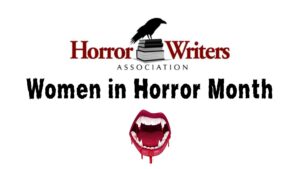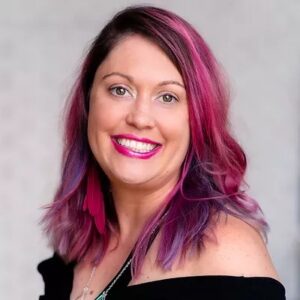Women in Horror Month 2024: An Interview with Jennifer Brody

What inspired you to start writing?
Believe it or not—I didn’t know I was going to become a writer! I planned to be a film director, and that’s what I studied in college at Harvard. Growing up in a small town in Virginia in the 90s, we didn’t have access to the internet or information like we do now. Also, the “YA” explosion hadn’t hit yet. The books we read in school (largely by “white” men) didn’t resonate with me. I couldn’t see myself in them, or how I would write them. But I gravitated heavily to Anne Rice and Stephen King, who are massive influences. I did latch onto the idea of making films. However, when I arrived in Hollywood, it quickly became clear there wasn’t a viable path as a woman to direct (it’s not any better now). I moved instead to the producer and studio side at New Line Cinema, working primarily with writers on films based on books like The Lord of the Rings and The Golden Compass, but also horror like The Texas Chainsaw Massacre remake and prequel and Freddy vs. Jason. Slowly, through that exposure and the shifts in the industry, I realized that I wanted to write books. Writing screenplays might have been an easier path forward, but I fell in love with the big worldbuilding stories like the ones we were making into films. That led me to pen my debut trilogy, The 13th Continuum. That started my writing journey.
What was it about the horror genre that drew you to it?
Similar to not realizing I would become an author, I didn’t intend to write horror either. In retrospect, it should’ve been obvious. My favorite authors were horror writers, and my favorite films, too. The first two films I worked on were Donnie Darko (as an intern) and then The Texas Chainsaw Massacre remake. I later developed Leatherface’s backstory with Dave Schow. My favorite film of all time is The Shining. I also met Clive Barker during this time. Hellraiser is my favorite horror franchise. I also love Candyman. New Line is the “House that Freddy built.” I worked directly for Bob Shaye, and my desk was even from the “New Nightmare” film. Still, I didn’t realize that I would become a horror author. My debut book series was dystopianv science fiction. But then Disney called me up to audition to write “Disney Chills”—a new middle grade horror series featuring Disney villains haunting kids. Having grown up on Goosebumps and Disney films, this was right up my alley. I loved that Disney wanted to hire me to scare kids. The series debuted with Part of Your Nightmare featuring Ursula to great success, even though we had to launch in Spring 2020 during the height of the pandemic. The series quickly expanded to five books, then seven, and was translated all over the world. Meanwhile, my short story work started to delve heavily into horror, and then I decided to write graphic novels. My first graphic novel Spectre Deep 6 went on to become a Finalist for the Stoker Award. So, you could say, horror found me. Not the other way around! And now, it won’t let me go!
Do you make a conscious effort to include female characters and themes in your writing and if so, what do you want to portray?
Yes, without question. I learned working in film that horror is the genre of the strong female protagonist. Mary Shelley is one of my heroes. As a teenager, she wrote the first science fiction novel. I’m on a panel about her at the upcoming WonderCon. I wouldn’t be the writer that I am without Anne Rice. So, it comes very naturally to write female protagonists. I love that horror allows them to fight evil and darkness, but I also love making them complicated and highly imperfect. On the flipside, I enjoy writing villains like Ursula, Cruella De Vil, and Maleficent—some of the most fascinating and enduring villains. I love that in horror novels and stories, the villain can be the protagonist in horror! Or the protagonist can become the villain. I also got to pen a Darth Vader canon story for LucasFilm in Star Wars: Stories of Jedi and Sith. Anakin is my favorite SW character and one of the best “fall” character arcs of all time. Of course, in that story, I created a new rebel character—a teen female Wookiee—to face him.
What has writing horror taught you about the world and yourself?
Horror allows me to process some of the problems and terror in the world. I can make us feel less alone in dark times. It’s a space where we can tackle these problems, even allegorically by embodying them in a problem or villain, and show how humanity can survive to live another day. For kids, I think it teaches resilience in a safe space of a story and is critical to growth and development. Disney Chills is particularly popular with middle school students right now.
How have you seen the horror genre change over the years? And how do you think it will continue to evolve?
Horror always evolves! It’s one of the things I love most about it. I mean, all genres are always changing. Horror is fun because the fears, paranoias and preoccupations it tackles correspond directly to what’s going on in the world. It’s similar to science fiction, which I also love, and the mash-up of the two genres together is a sweet spot for me. I’m curious to see what happens post-pandemic and also with AI coming heavily into existence, two things that horror has always tackled, but I wonder if the approach will change now. Climate change also has been factoring heavily into a lot of my work going forward. For example, my recent story, “The Night Caravan” that appeared in the anthology, The Good, the Bad, and the Uncanny, is a sci-fi/horror blend that takes place in a post climate change Earth that is blighted and nothing grows.
How do you feel women have been represented thus far in the genre and what hopes do you have for representation in the genre going forward?
As mentioned, horror is often credited with being the genre that has the best representation for female characters, including as the villains. I’d love to see this approach continue, along with complexity built into them. That said, I do think we lack female writers, creators, and directors. In my experience, we are still in the minority even in a genre that features female characters. I’d love to see more younger writers encouraged to embrace horror writing. This is part of why I love writing under my pen name, “Vera Strange,” for younger/middle grade readers.
Who are some of your favorite female characters in horror?
This is such a LONG list! Where do I start? Ripley from Alien—and I would love to work with that IP (hint, hint Disney!). I love any blend of SFF and Horror. Clarice Starling. Kirsty Cotton. But I also love the iconic villains I’ve written. Ursula is a queen and sea witch. Maleficent is my favorite Disney villain of all time! I’m also obsessed with Cruella De Vil (she even gave ME nightmares when writing her for Be Careful What You Wish Fur) and the Evil Queen, of course.
Who are some women who write horror you recommend our audience check out?
Anne Rice. I wouldn’t be a writer without her influence. I love how transgressive her work was (some of which has been stripped out in the new shows, sadly). Mary Shelley, forever and always. Tananarive Due (I’m so excited to read The Reformatory and have it on my shelf). My friend Delilah S. Dawson from the Star Wars anthology. The Violence was so fantastic, and I’m excited to read her new novella, Bloom. I love my colleague Serena Valentino’s Disney “Villains” series! Ally Malinenko’s Ghost Girl. I’m so excited for her new book Broken Dolls.
What is one piece of advice you would give horror authors today?
Don’t be afraid of the darkness. The complexity. Go to places where it hurts. Be transgressive even, like Clive Barker and Anne Rice. And write for younger readers, but don’t write “down” to them or pull your scares! Tackle the important issues of our time through a horror lens.
And to the women who write horror out there who are just getting started, what advice would you give them?
Seek out mentors. Read extensively. Look at what scares you–what your darker preoccupations are–and channel that into your stories. Don’t apologize for wanting to terrify readers! Embrace it. Don’t listen to anyone trying to “censor” you and convince you to write “nicer” stories. Even if you’re not technically writing “horror,” a story is always only as strong as the villain or conflict. Short stories are a great place to flex and explore. I also recommend the HWA. Of all the professional author groups, they’ve been the most welcoming to me (in my experience).
 JENNIFER BRODY (a/k/a VERA STRANGE) is the Stoker nominated author of the Disney Chills book series, The 13th Continuum trilogy, and for Spectre Deep 6, which was a Stoker Finalist for Best Graphic Novel prompting Forbes to call her “a star in the graphic novel world.” She is the co-author of All is Found: A Frozen Anthology and Star Wars: Stories of Jedi & Sith, where she penned the Darth Vader story. She’s a graduate of Harvard University, a film/TV producer and writer, and a creative writing instructor. She began her career in Hollywood working for A-List directors and movie studios on many films, including The Lord of the Rings trilogy, The Golden Compass, Freddy vs. Jason and The Texas Chainsaw Massacre. Her forthcoming stories will appear in Weird Tales and among other anthologies, while her forthcoming series A Sacrifice of Blood & Stars sold in a 3-book deal and debuts in Fall 2024. She lives and writes in Joshua Tree, California. http://www.jenniferbrody.com/
JENNIFER BRODY (a/k/a VERA STRANGE) is the Stoker nominated author of the Disney Chills book series, The 13th Continuum trilogy, and for Spectre Deep 6, which was a Stoker Finalist for Best Graphic Novel prompting Forbes to call her “a star in the graphic novel world.” She is the co-author of All is Found: A Frozen Anthology and Star Wars: Stories of Jedi & Sith, where she penned the Darth Vader story. She’s a graduate of Harvard University, a film/TV producer and writer, and a creative writing instructor. She began her career in Hollywood working for A-List directors and movie studios on many films, including The Lord of the Rings trilogy, The Golden Compass, Freddy vs. Jason and The Texas Chainsaw Massacre. Her forthcoming stories will appear in Weird Tales and among other anthologies, while her forthcoming series A Sacrifice of Blood & Stars sold in a 3-book deal and debuts in Fall 2024. She lives and writes in Joshua Tree, California. http://www.jenniferbrody.com/



